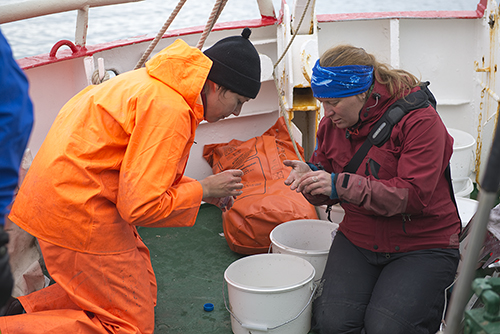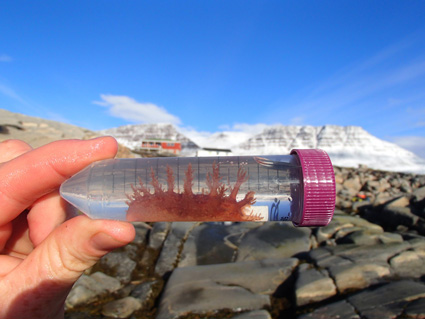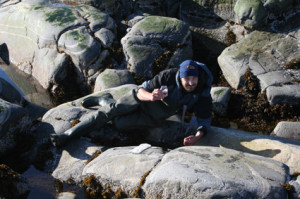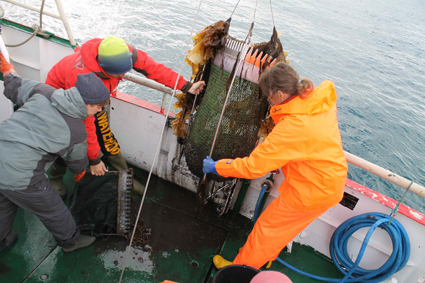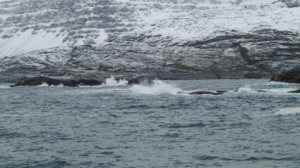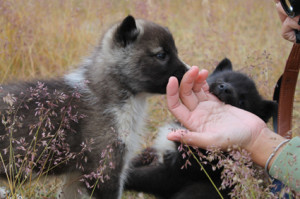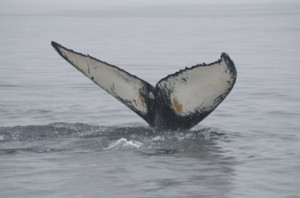Waking up bright and early Monday morning we all eagerly awaited a call from the captain of Porsild on whether we would be able to go on our sampling trip to Disko Fjord or once again have to change our plans due to bad weather. The call came and like a child on Christmas morning our eyes glistened with hope.
Yes! We are going!
The weather was even good enough to take the small speedboat with us, so three brave guys dressed up in teletubby-like survival suits, which are one size that really fits no one.
We were told this little boat would be slightly faster than Porsild, and as we steamed out of the harbor doing approximately 5 knots it raced passed us at the speed of light with the mighty Johannes at the helm.
On the Porsild we were all taken by the beautiful scenery, large icebergs and steep cliffs that plunged into the sea made almost every moment a Kodak one. The sea was calm and not a single whale spotted so the trip was somehow uneventful in this matter.
For our speedboat crew the story however was quite the opposite. Having arrived hours ahead of Porsild, our brave boys decided to do some fishing. This resulted in them catching not one, not two, but six large cods which we later prepared for dinner with the only spices at our disposal, salt and beer.
They also had a taste of the Inuit everyday life when a curious seal approached the boat. Quicker than any gunman in the wildest of the west, Johannes reached for his rifle and that seal is now swimming happily in the eternal seas.
At the arrival of Porsild we all met up for some sampling of blue mussels. Oddly enough, the only one of us who actually works with this organism was still at the Arctic Station having us do his dirty-work for him. What a clever Dane he is, that Jakob.
Sorting mussels
So, after replicating sampling grids and sorting and cleaning mussels until our fingers were the same temperature as the surrounding water we headed to a nearby village, population of 50.
Half of us were to spend the night on Porsild and the other half were camping on land and therefore had packed both warm sleeping bags and thermal mattresses. The “campsite” turned out to be a house where government officials stay while visiting the area so needless to say, our campers was not particularly uncomfortable in their palace with a panorama view of the fjord and surrounding mountains.
After a good night on board Porsild being gently rocked to sleep by the sea we woke up to the smell of fresh coffee ready for an exciting new day in Disko Fjord.

First on the agenda(after collecting our campers) was to go look for a radioactive hotspring, not to worry though, it was not radioactive enough to make us glow in the dark. Even for the crazy German Andreas who walked barefoot.
This spring is homeothermic and thus never freezes. This creates a very unique environment that allows species like orchid and Angelica to grow in an otherwise harsh environment. Rumor has it that the vikings used to smoke Angelica and further the Inuits have a tradition of using it for producing an alcoholic beverage.
So, armed with GPS-coordinates and survival suites very suitable for boat rides in the arctic (but definitely not for long walks) we were put to shore within a short walking distance from this elusive spring. Or so we thought.
Apparently our captain didn’t care much for those coordinates. This could either have been a miscommunication (none of us speak Inuit very well) or he just felt we needed some exercise (he was probably right considering the high amount of potatoes and gravy in our diet up here…), because we ended up walking up and down moss-covered hills for about one kilometer before reaching said spring.
Finally there, everybody was on their hands and knees taking pictures from all kind of weird angles of Angelica, gypsum fluorite precipitation on rocks and withered orchids. Surprisingly enough, the orchids were no longer flowering at this time a year – but what do a bunch of marine biologists know about that stuff anyway.
Photographing Angelica can be tricky Gypsum fluorite precipitation
Back on the boat we had a very quick cup of coffee and then off we went for the next agenda of the day, Lithothamnion sampling!
Lithothamnion are coralline red algae which creates either crusts on rocks or globular aggregations on the seafloor. These globular Lithothamnion were of particular interest due to their importance in creating unique habitats for meiofauna…
So tune in on our blog tomorrow for more exiting scientific facts about this topic.
Written by: Mette (Aarhus University) & Jenny (Gothenburg University)



























